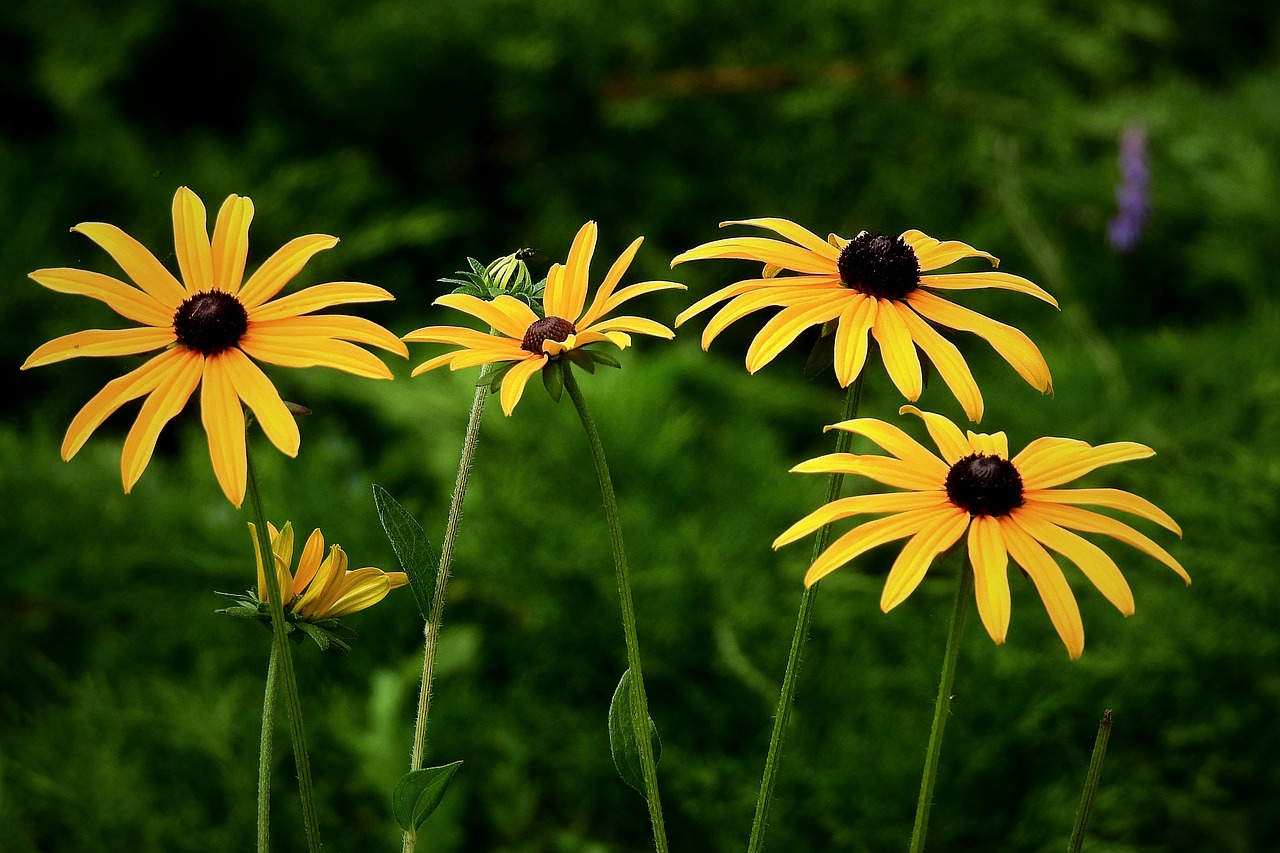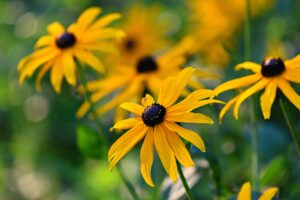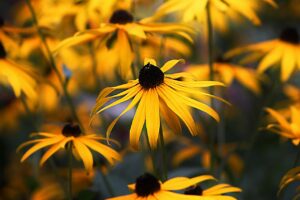Black-eyed Susan
Overview
The Rudbeckia hirta, commonly known as Black-eyed Susan, is part of the Asteraceae family. This easy-to-grow plant features distinct yellow petals and a dark brown center, making it a radiant addition to gardens, attracting birds and butterflies. It’s a robust perennial or biennial that thrives in sunny spots and can adapt to various soil conditions, with the added benefit of drought resistance. Blooming from mid-summer to early fall, it also serves as a charming cut flower.

Characteristics
Known for its showy yellow to orange-yellow flowers with dark brown centers, drought tolerance, and attraction to birds and butterflies.
Region
Native to the Central and Eastern United States and commonly grown in temperate regions.
Natural Habitat
Fields, roadsides, open woods, and prairies.
Cultivation
Prefers full sun to partial shade, requires moderate water, and thrives in various soil types, except waterlogged soils.
Uses and Benefits
- The Rudbeckia hirta, widely known as Black-eyed Susan, adds vibrant color to gardens, attracting birds and butterflies, which are essential for pollination and ecosystem health.
- Its bright, daisy-like flowers with dark centers are sought-after for bouquets, providing an aesthetically pleasing addition to floral arrangements.
- Adaptability in various soils and resistance to heat and drought make it a practical choice for gardeners dealing with challenging climates.
- When it comes to growth, Black-eyed Susans create a visual impact with their large clumps, suggestive of their vitality and robust nature.
This herb serves not only as a lovely ornamental feature but also plays a role in supporting local wildlife and enhancing biodiversity in the home garden.

Cultivation Tips
Growing the Rudbeckia hirta, commonly known as Black-eyed Susan, is quite simple with the following cultivation tips:
- Propagate from seeds to encourage mass plantings.
- Choose well-draining soil to prevent root rot, although the plant can thrive in a range of soil types.
- Ensure the location receives full sunlight, though partial shade is tolerable.
- Water moderately, as Black-eyed Susans are drought-tolerant once established.
- Expect a delightful display of blooms from June to September.
With these tips, you’ll enjoy the beautiful yellow to orange-yellow flowers and the benefits they provide for birds and butterflies.
Seasonal Considerations
The bloom time of the Black-eyed Susan (Rudbeckia hirta) is a key seasonal consideration for gardeners. Here are the main points to remember for those looking to grow this vibrant plant:
- Peak flowering occurs in mid-summer, transforming gardens with a showy display of color.
- Expect blooms from June, with a potential starting flourish in late spring.4
- The blossoming season stretches through September, sometimes into early fall, depending on local climate conditions.2
- To ensure a robust flowering period, provide full sunlight and well-draining soil.
- Maintenance during the blooming period is minimal, making it an ideal choice for low-effort landscaping.1
To maximize the impact of Black-eyed Susans in your garden, plan ahead to enjoy their full seasonal potential.

Issues and Troubleshooting
- Overwatering: If the Rudbeckia hirta is in soggy soil, root rot may occur. Ensure the soil is well-draining.
- Pests: Aphids and spider mites might compromise plant health. An insecticidal soap can help manage these pests.
- Diseases: Watch out for powdery mildew and leaf spot. These can be mitigated by proper air circulation around the plants and avoiding overhead watering. Fungicides may be necessary in severe cases.
- Foliage Problems: Yellowing leaves could indicate excessive water or poor soil fertility. Adjust watering and consider a balanced fertilizer.
Regular monitoring and correct watering practices can prevent most issues, ensuring that your Black-eyed Susans remain healthy and vibrant.
History and Folklore
The Rudbeckia hirta, commonly known as the Black-eyed Susan, carries a charm that transcends its sunny appearance, rooted in folklore and history. Native American tribes revered the plant for its medicinal properties, using it in remedies for colds, flu, infection, and swelling. As American settlers moved west, the flower became a symbol of the pioneering spirit owing to its resilience and widespread presence. The dark center of the flower was thought to protect against evil spirits, and it was often planted around homes for this purpose. This historical narrative not only enlightens us about past uses but also enriches the cultivation of this cheerful plant in modern gardens.
References
1. Black-eyed Susan – North Carolina Extension Gardener Plant Toolbox, https://plants.ces.ncsu.edu/plants/rudbeckia-fulgida/common-name/black-eyed-susan/
2. Rudbeckia hirta – Plant Finder – Missouri Botanical Garden, https://www.missouribotanicalgarden.org/PlantFinder/PlantFinderDetails.aspx?taxonid=277225
3. Rudbeckia hirta (Black Eyed Susan, Black-eyed Susan, Gloriosa Daisy …), https://plants.ces.ncsu.edu/plants/rudbeckia-hirta/
4. Black-eyed Susan | UMass Amherst Greenhouse Crops and Floriculture Program, https://extension.umass.edu/plant-identification/black-eyed-susan
5. Black-eyed Susan | Description & Facts | Britannica, https://www.britannica.com/plant/black-eyed-Susan-plant
Image Credit: 5892437
Image Credit: MabelAmber
Image Credit: Naturelady
Nicolas Duval
Nicolas is a passionate advocate for nature and the art of wildcrafting. His dedication shines through in Wildcraftia, a website he meticulously crafted to serve as a haven for nature enthusiasts worldwide. Driven by a deep appreciation for nature’s connection to humanity, Nicolas embarked on his journey in 2011 with SmokableHerbs, a platform showcasing his love for nature’s bounty. Building upon this foundation, he established Smokably, a thriving online store offering premium herbs and blends to a global audience.
